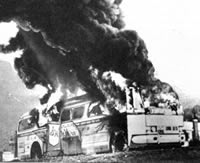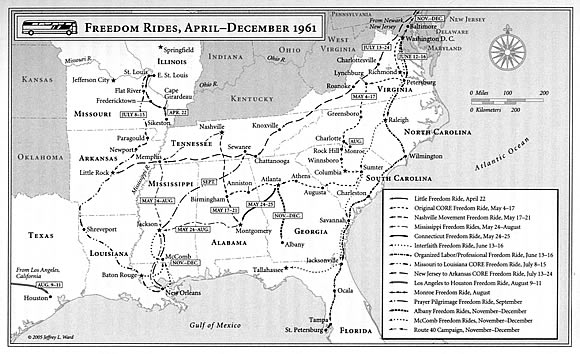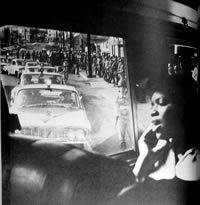Posted May 5, 2011
May 4th was the 50th anniversary of the Freedom Rides, when a dozen interracial riders, organized by the Congress of Racial Equality (CORE), challenged segregation in bus accommodations across the Deep South. They were determined to use non-violent direct action to implement a 1960 U.S. Supreme Court decision that declared segregated restaurants and waiting rooms at interstate transportation terminals. The ride, like an earlier one in 1947 CORE had undertaken in the Upper South, was composed only of men. (From the beginning women had demanded to be included, but CORE was insistent that only men face the danger.) The first bus was firebombed outside Anniston, Alabama and the second one was boarded by eight Ku Klux Klan members at the bus terminal. They beat the Black activists and whites like Walter Berman, a retired Wayne State University professor who intervened and was so badly beaten he ended up in a wheelchair for the rest of his life.
 Determined to get to New Orleans in time for a rally, the activists decided to fly, and found the Klan succeeded in closing the airport until federal intervention got them in the air. Fearing that someone would be killed, CORE called off the rides.
Determined to get to New Orleans in time for a rally, the activists decided to fly, and found the Klan succeeded in closing the airport until federal intervention got them in the air. Fearing that someone would be killed, CORE called off the rides.
When Diane Nash, chair of the earlier Nashville sit-ins and already a SNCC organizer, heard the news she convened a group who decided it was necessary to continue, even if they were to die. Otherwise, mob rule would reinforce Jim Crow practices. Ten Nashville students, seven men and three women, made out their wills and traveled to Birmingham to restart the rides. They were confronted by mobs and police in Birmingham and Montgomery. Many made it to Jackson, where they were arrested, imprisoned and often beaten by the police. The Freedom Riders embraced the “Jail, no bail” principle, inviting others to follow, and fill the jails. Over 300 riders were arrested in Jackson and after the city and county jails were filled, they were sent to the notorious Mississippi State Penitentiary, known as the Parchman Farm.

Click for a high-resolution map from The Civil Rights Movement Veterans Homepage.
As a 21-year old white woman, I’d traveled through the South on my way from San Francisco to New York City just two months’ earlier. I’d first encountered Southern-style segregation when I walked into the Houston train station and sat down, waiting for the next train going east. I noticed that all the whites were sitting on the other side of the station. I wondered how people seemed to self-segregate, and after a few minutes discovered that over separate doors it said “Colored Passengers” and “White Passengers.” It was a recently built station, with the newspaper/candy stand in the middle. Unlike the Atlanta station I encountered a few days later, the separation of races was not a wall or half-wall but imposed by signs and the concession stand in the middle of the terminal. Blacks would buy from one side, whites from the other.
 While traveling through the South that February, I stuck the Black side of the terminals and used the Black drinking and restroom facilities. No one ever talked to me–and I later realized that I must have been viewed as crazy or just a foreigner traveling through.
While traveling through the South that February, I stuck the Black side of the terminals and used the Black drinking and restroom facilities. No one ever talked to me–and I later realized that I must have been viewed as crazy or just a foreigner traveling through.
Coming right after the heels of the sit-ins, the Freedom Rides involved 436 people in 60 separate attempts to ride on buses, trains and planes, directly challenging Jim Crow. I came to know several of the riders, and as an editor at the Catholic Worker, edited one rider’s prison letters for the paper. Certainly for my generation, the sit-iners and riders were our heroes. We also knew that the police and government officials at every level were eventually forced to enforce the law because of the actions of ordinary people, who commanded public support through their determination.
The sense of being able to change history didn’t just stop with the end of the freedom rides, but led to many other projects, North and South. It was particularly empowering for women. When Headstart was passed and funded, I went to Mississippi the summer of 1965 to help set up schools in the African-American community. Since Mississippi had never had public kindergartens or pre-schools, I set up a sample classroom for teachers and community workers and facilitated a classroom in Holly Springs. I lived with an activist family.
Over the years, when I hear politicians or union officials explain how we need to lower our expectations and take concessions, I remember how the destruction of Jim Crow changed the definition of what was possible in American life.
You might be interested in reading Freedom Riders, Raymond Arsenault’s gripping account, which I reviewed for Against the Current. The book has recently been made into a movie and will be shown on PBS’s American Experience on May 16. Be sure to look for it!
